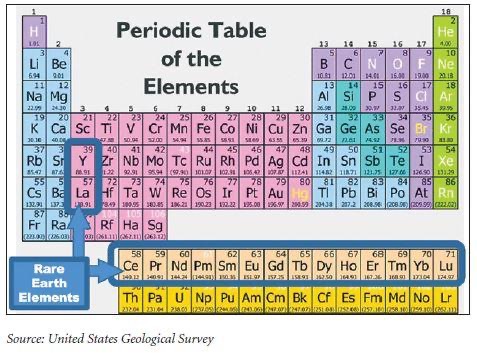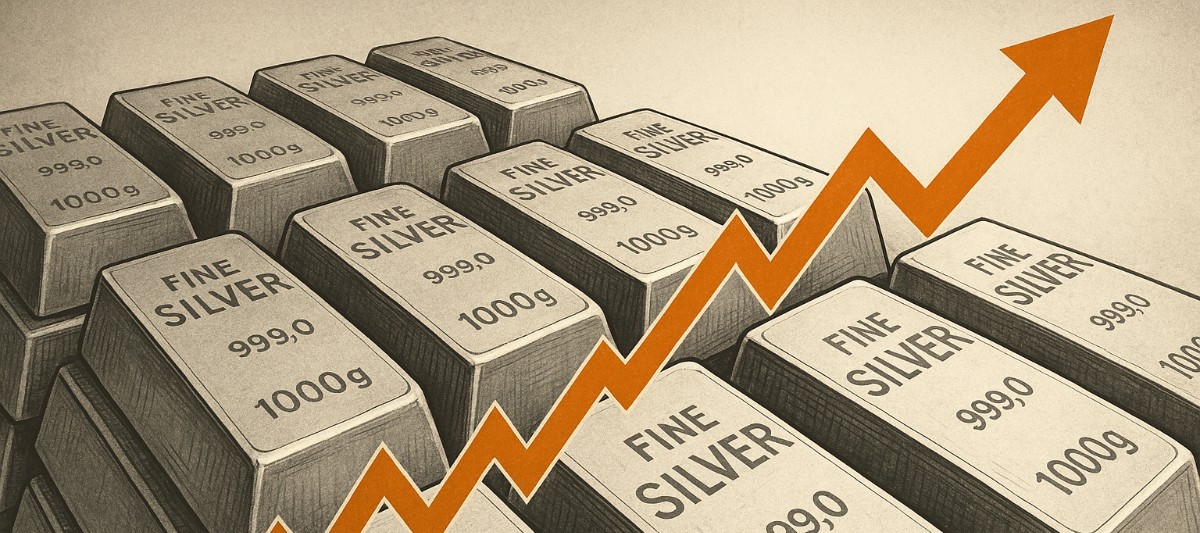
Posted May 22, 2024
King: About Rare Earths
“You may not be interested in rare earths, but rare earths are interested in you.”
That quote is a riff on a famous comment by Leon Trotsky regarding war. Trotsky pointed out how war is “interested in you,” but in this piece, we’ll aim lower, to a group of exotic elements from deep within the periodic table.
I’ll give you a couple of ideas on how you might even make a few bucks. We’ll discuss rare earth elements (REEs), which are all around you (see below).
Plus, as we’ll see in a moment, the possible lack of REEs is our real problem. Because without REEs, much of the technology around us could come crashing down on our collective head.
First, a quick trip down memory lane. As in, did you study chemistry in high school or college? And don’t worry, this isn’t an advanced chemistry class. No slide rules are required. (Oh wait, what’s a slide rule?)
All you need is a rudimentary understanding of the periodic table. As in… Just know that the periodic table exists and a few broad details. And voila, here’s a copy, courtesy of the U.S. Geological Survey:

Okay, back to school. Do you remember chemistry class? In the olden days, every chemistry classroom had a copy of the periodic table hanging on the wall. Maybe you’d stare at it and try to figure out what all those little letters and numbers meant.
And there was the chemistry teacher up in front, discussing protons, electrons, oxygen, hydrogen, carbon, nitrogen, acids, bases, and much more. See? It’s coming back to you (and not in a bad way, I hope).
Now, do you remember your chemistry tests? Two hydrogens plus oxygen make water. Sodium and chlorine form table salt. Iron and oxygen make rust.
And do you recall how you sometimes wondered what would be on the next test?
Of course, there was always this one kid back in school, right? He (or she) was the one who raised a hand and asked the teacher about the elements at the bottom of the chart.
The teacher might reply that the two rows at the bottom are called lanthanides and actinides. And the kid would then ask what do we need to know? Are they on the test?
The teacher would look at this precocious student, sigh a bit, and say something like, “Don’t worry. That stuff is pretty advanced for this level. It's not the kind of material we cover. No, they’re not on the test.”
And everybody in the classroom let out a collective “Whew!” Because you dodged a bullet, right? You didn’t have to learn anything about lanthanides. They weren’t on the test.
Except now, fast forward to today. We live in a different world.
It turns out that those lanthanide elements at the bottom of the periodic table are important. They comprise the rare earth elements that a lot of people talk about.
And now, today… They. Are. On. The. Test.
Why do you have to know about lanthanide elements? Or, to say it another way, what’s with those rare earth elements (REEs)? Well, you may or may not realize this, but REEs very much control your life.
Indeed, absent REEs, you have no modern existence. Seriously, without REEs, your advanced lifestyle these days would be zero, zippo, nada. You may as well be living in 1824, not 2024.
The fact is that you are surrounded by lanthanides. Pretty much everything that makes modern life possible has some basis in them, meaning REEs.
Your smartphone and computer? They won’t work without REEs.
Television and all the cable or wireless hookups? REEs, amigo.
The light bulbs in your house and office? They are probably REE-based unless they’re from an old stash of tungsten filament. But once the old bulbs are gone, you’re living with REEs.
Your refrigerator and microwave oven? REEs, absolutely.
The electric power in your wires? Ha! Absent REEs, you won’t have electricity. Power plants use REEs in the electronics and generating systems. And solar and wind power use even more REEs in the electronics and related components.
Your car won’t work without REEs, and if it’s an electric car, that goes almost without saying.
Even if it’s a gasoline car, absent REEs, you won’t have fuel. Refineries require REEs in the process of cracking petroleum.
How about agricultural equipment that helps farmers grow food? Yes, REEs.
Or equipment that harvests and processes food? REEs.
The logistical system that keeps food fresh and distributes it to stores? REEs.
If you think you’ll just drop out, go live in a log cabin, and burn wood, I have some news: most flints in fire-starting kits are made of… yes, REEs. (“Mischmetal,” to be exact, is a German word that means a mix of several REEs.)
Need I go on?
Perhaps this is a surprise. Maybe you didn’t already know how critical REEs are to pretty much everything.
Then again, it’s not like our modern world explains itself to everyone. You must dig out the information, although it’s there if you know where to look.
Along these lines (and usually when you see news articles about REEs), it’s in the context of how we need REEs for military and defense equipment.
Yes, REEs go into ships, airplanes, ground equipment, electronics, and even pretty much all of the ammunition, certainly anything with a guidance element. REEs are in a long list of just about everything. It may just be a fraction of an ounce of REE in one electronic application or another to make the circuitry work. But absent REEs, those circuits won’t do squat.
Or it might be a few pounds of REE in the guidance-control fins of a missile. Or about 1,000 pounds of REE in the overall construction of an F-35 fighter jet. Or many tons of REE in a nuclear submarine's drive motors and sonar transducers.
You’ll also find REEs in unexpected places, like futuristic tank armor. In fact, a few years ago, I visited the Army Research Lab in Aberdeen, Md., and learned how REEs alloy with iron to make various kinds of steel. Just a small amount of REE additive (essentially “mischmetal,” like from lighter flints above) can significantly improve the strength of armor plate.
And here’s something else that’s beyond astonishing. For all the REEs that go into that vast array of products, and for as critical as REEs are to empowering the modern lifestyle, it’s all a recent development by historical standards.
Most REE elements were discovered in the late 1700s and through the 1800s, in the olden days of basic science. But REE applications didn’t begin to come to market until about the 1960s and 70s—not long ago at all.
If you’re of a certain age, you may recall one of the first uses of REE in mass-market products. The old RCA color television set used the element europium to bring out the color red in a cathode ray tube.

Of course, today’s flat-screen televisions are leaps and bounds ahead of the old RCA. But again, you won't see anything absent in REEs in today’s products.
To make a long story short, various REEs enhance magnetic properties or improve electronic or optical properties. It’s why REEs are critical to strong permanent magnets or as phosphors in new lighting systems, and much more.
This all has to do with quantum chemistry, which is why REEs present unique properties in terms of physics. So, when people say that we can somehow substitute some other element for REEs, generally, they don’t understand the chemistry. Because the only reason you have a certain effect from a certain RE element is because of that element’s unique electron structure.
There’s no substituting element X for element Y in the arena of REEs. Maybe you can use less of something and still get about the same field effect. But if you need, say, neodymium for a certain kind of magnet or gadolinium as a certain kind of phosphor, then you need that exact element and not something else.
This gets us to the source of REEs. Where do they come from? (Answer: originally, from supernovas of many billions of years ago. But let’s stick with planet Earth.)
Well, you’ll hear people say that REEs are relatively “common” in the Earth’s crust, which is not entirely wrong. They are just mostly wrong in our ability to extract them.
In terms of crustal abundance, REEs are more common than silver, for example. But regarding ore deposits for REEs, they’re tricky to extract. It gets back to chemistry.
In the early days of REEs, in the 1950s and 60s, much of the world’s supply of REEs came from an ore deposit at Mountain Pass, California. Indeed, the europium in old RCA television sets was likely mined from Mountain Pass.
But then in the 1980s, along came… China. And yes, you likely know the drill. China has geography and geology that offer REE-bearing ores. Plus, there are low wages, little environmental protection, and state-level tight industrial planning and control. Over not too long a time, China essentially undercut the REE business in the U.S. and the very few other working resources in the rest of the world.
By 2010, China controlled about 94% of global REE output. It’s a mere 85% today, depending on whose numbers you want to believe. The point is that when it comes to REE, the issue has been and remains China-China-China.
China dominates the production and most upstream output of REE-based products. This means mines, mills, refineries, and early-stage manufacturing of oxides, salts, and powders. They have the people, plants, equipment, research pipelines, universities, and more.
How about the rest of the world? Sure, a plant here or there. But make no mistake; China has the world over a barrel when it comes to supplies of REE.
For all the happy talk about revising a REE sector in the U.S., Canada, the rest of the West, etc., it’s a hard climb. Precious few people in the West have the chemical and metallurgical skills to make a go of it. Most of the world’s leading people in the field speak Chinese as their first language.
Meanwhile, the issue is easy to understate and misunderstand. After all, China’s REE sector probably scales in the range of about $25 billion per year, which doesn’t sound like all that much in a world of multi-trillion-dollar U.S. government deficits.
But China’s $25 billion REE sector supports a global range of products (from television sets to sonar transducers) that add up to multi-trillions. China controls the REE pipeline, period. And REE could very well become the next Pearl Harbor for both the U.S. and the West.
Of course, we see efforts to rebuild a REE sector in the West, but it’s a generational issue even if everything goes right. And things seldom go right, although I’ve personally visited a couple of companies that are on the right track.
Energy Fuels Corp. (UUUU) has a plant in Blanding, Utah that processes uranium and vanadium ores and is just now ramping up a circuit to extract REE. Another company with a much smaller market cap is Ucore (UURAF). It has a working demonstration plant in Kingston, Ontario that can extract REE, and it’s building a much larger facility in Alexandria, Louisiana.
Plus, in my view,, one of the best REE ore deposits in North America is in Wicheeda, British Columbia, under the control of Defense Metals (DFMTF), a company with a quite modest market cap.
I’m not formally recommending these companies as investment plays, and we won’t track them for you. But they’re worth a look. Follow the charts, buy on down days, never chase momentum, and be patient as the REE saga unfolds at its own pace.
Oh, and it’s worth it to appreciate all the lousy policymaking and failed, ignorant leadership in Washington, D.C., over many years that brought us all to the edge of this cliff.
That’s all for now… Thank you for subscribing and reading.

Icing The Green New Scam
Posted December 17, 2025
By Sean Ring

8 Things That Will Turbocharge The Gold Price
Posted December 16, 2025
By Jim Rickards

Can Miners Double Again?
Posted December 15, 2025
By Sean Ring

How FDR Put America Behind Golden Bars
Posted December 12, 2025
By Byron King

Swamp Thing
Posted December 11, 2025
By Sean Ring
